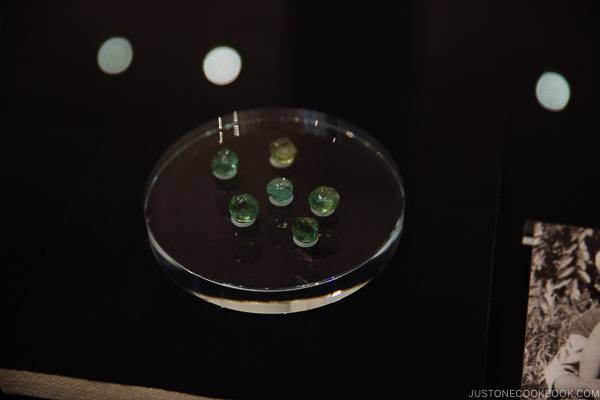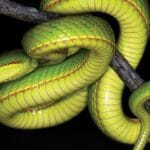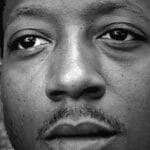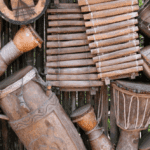The period between the 1940s and 1960s witnessed nuclear attacks and tests that starkly revealed the terrifying power of these devices. While the World War II bombing of Hiroshima is widely known, the experiences of the Enola Gay pilots and Australia’s exposure to a bomb twice the size of Hiroshima’s are less so. This list delves into some unsettling narratives, including the man who survived two nuclear blasts and scientists who experimented with atomic-irradiated beer.
10. The Impossible Mineral Created by the First Nuclear Test
The first-ever nuclear test, conducted in New Mexico on July 16, 1945, resulted in the creation of a new mineral called trinitite, which resembled green glass. This glass formed from the fusion of desert sand, asphalt, the test tower, and its copper wires due to the explosion.
Decades later, a startling discovery was made within this glass: quasicrystals, which were previously considered impossible. Unlike regular crystals with orderly or disorderly atomic arrangements, quasicrystals possess “in-between” traits. Officially acknowledged in 1984, quasicrystals have since been found in meteorites and created in laboratories.
The conditions required for quasicrystal formation—extreme temperature, shock, and pressure—aligned with those present during atomic blasts. The quasicrystal found in the trinitite was unique, featuring 20 sides and a complex internal structure that defies explanation.
9. Operation Teapot: Atomic Beer?
The Nevada desert hosted numerous nuclear tests, including Operation Teapot, which sought to answer an odd question: Could beer survive a nuclear attack and still be drinkable? In 1955, bottles of soda and beer were positioned at varying distances from ground zero. Some were close, about 322 meters (1,056 feet) away, while others were placed several miles away.
Operation Teapot involved the detonation of 14 nuclear bombs, two of which were used to test the beverages. These blasts were equivalent to 20 and 30 kilotons of TNT. After the explosions, researchers sampled the beer. Those who tasted it reported that it was palatable, except for the bottles closest to the blast. Fortunately, further tests indicated that the beverages were safe to drink, with only slight radioactivity.
8. Radioactive American Honey
In 2017, a teacher assigned his students a project to demonstrate the persistence of fallout from the 1950s and 1960s nuclear tests in the environment. Students brought in food from local gardens and markets, and as expected, many samples contained traces of caesium-137, a radioactive isotope found in fallout.
One bottle of honey stood out, exhibiting 100 times more caesium-137 than any other sample. Intrigued, researchers collected 122 samples of raw and unfiltered honey from beekeepers and markets across the eastern US. Around 68 samples contained the radioactive isotope.
The high radioactivity in honey is attributed to plants absorbing the isotope from the soil and storing it in nectar. Bees then concentrate the isotope when they turn the nectar into honey. Despite these findings, researchers assured that the levels of radioactivity are safe for consumption.
7. The Glass Beaches of Hiroshima

In 2015, geologist Mario Wannier analyzed sand samples collected from Hiroshima Port to assess the health of the Moto Ujina Peninsula’s marine ecosystems. During his analysis, he discovered tiny glass spheres, some melted or fused, others with tails, and some with a rubber-like texture. Up to 2.5% of each kilogram of sand collected from beaches as far as 12 kilometers (7.4 miles) away consisted of these glass particles.
The high concentration of glass suggested that it was fallout from the 1945 atomic bombing of Hiroshima. University studies confirmed that the glass contained metals, crystals, carbon, and oxygen. The composition indicated that the glass was formed from the vaporized buildings of Hiroshima.
When the bomb detonated, the materials of Hiroshima were drawn into the fireball, melted, and formed glass within the atomic cloud. As the cloud cooled, these glass spheres rained down on Earth.
6. The Vela Incident: A Mysterious Nuclear Blast
In 1979, the Vela-5B satellite, part of a network designed to detect unauthorized nuclear detonations, recorded a blast on September 22nd.
The explosion occurred in the air near the Prince Edward Islands in the southern Indian Ocean. Experts concurred that the event bore all the hallmarks of a nuclear bomb, including a double flash and an atmospheric wave. The estimated yield was 3 kilotons (the Hiroshima bomb was 15 kilotons).
Despite these indicators, surveillance aircraft found no evidence of the explosion, and no radioactive fallout was detected. Some suggest the satellite malfunctioned. However, many experienced professionals, including researchers at Los Alamos, remain convinced it was a nuclear test.
The identity of the nation responsible for the test remains a mystery. The most prevalent theory suggests a joint operation between South Africa and Israel, though France, India, and Pakistan are also considered possible culprits. No country has claimed responsibility.
5. The Maralinga Nuclear Tests in Australia
From 1956 to 1963, seven atomic bombs were detonated at Maralinga, Australia, by the British as part of a Cold War initiative. One of these bombs was twice the size of the Hiroshima bomb. The then Prime Minister of Australia, Robert Menzies, approved the tests without consulting his cabinet. There were smaller plutonium tests, where the substance was burned or detonated with TNT.
The fallout from these tests reached as far as Townsville, Brisbane, Sydney, and Adelaide. Servicemen exposed to the tests suffered severe consequences, with 30% eventually dying from cancer. It’s suspected that the scientists deliberately exposed humans to study the effects of nuclear blasts.
4. The Terrifying Tsar Bomba
During the Cold War, the Soviets sought to demonstrate their technological and military power with the Tsar Bomba. This massive device was 8 meters (26 feet) long and weighed 27 tonnes (29 tons).
In 1961, the bomb was tested over Novaya Zemlya. The crew piloting the plane carrying the Tsar Bomba had only a 50% chance of survival. Despite the risk, they proceeded to the test site and dropped the bomb. The resulting explosion was devastating.
The plane barely escaped. The detonation almost destroyed it, even though the crew was 50 kilometers (30 miles) away. The mushroom cloud reached a width of 100 kilometers (63 miles). A village 55 kilometers (34 miles) from the blast site was completely obliterated, and homes hundreds of miles away were severely damaged.
The Tsar Bomba released energy 1,500 times greater than the Hiroshima bomb, with the blast waves circling the Earth three times. Initially, the bomb was designed to be twice as powerful, but concerns that the fallout would affect the USSR led to a reduction in its yield.
3. Enola Gay Pilot Meets Hiroshima Victim
Koko Kondo was eight months old when the atomic bomb detonated over Hiroshima. Her house collapsed, but her mother managed to rescue her. Growing up, Koko witnessed the devastating aftermath and vowed revenge on the crew of the US B-29 bomber responsible.
In 1955, Koko and her family were invited to America to share their story on a TV show. The producers arranged a surprise meeting with Captain Robert Lewis, the co-pilot of the Enola Gay, who had famously written in the plane’s logbook, “My God, what have we done?”
Initially, Koko wanted to attack Lewis. However, she noticed his tears, and instead of acting violently, she walked over and held his hand. Lewis’s remorse and the meeting transformed her hatred into forgiveness, teaching her that war causes suffering on both sides. Koko regretted not thanking Lewis before his death in 1983.
2. The Other Pilot’s Descent into Crime
Major Claude Eatherly, who flew the weather aircraft to assess the visibility over Hiroshima, played a direct role in the bombings of Hiroshima and Nagasaki. His favorable report led to the decision to drop the bombs.
Eatherly was deeply affected by the destruction and suffered nightmares. He struggled with mental health issues and was arrested for petty crimes and even armed robbery. A jury released him, believing that the bombings had driven him insane.
Eatherly eventually became an anti-nuclear activist. Before his death at age 59 from cancer, he identified himself to the people of Hiroshima as the man who gave the go-ahead for the bombing and expressed his regret. Like Koko’s reaction to Captain Lewis, 30 bomb victims wrote to Eatherly, acknowledging him as a victim of war as well.
1. The Man Nuked Twice
On August 6, 1945, Tsutomu Yamaguchi was in Hiroshima on a business trip. As he walked near a shipyard, he witnessed the Enola Gay drop the bomb. He sought shelter in a ditch, but the shock wave threw him into the air, severely burning his skin.
Despite his injuries, Yamaguchi returned to his family in Nagasaki, wading through a river filled with bodies to reach the train station. His mother didn’t recognize him due to his burns.
On August 9, while at work, Yamaguchi was explaining to his boss that a single bomb had destroyed Hiroshima, when Nagasaki was also bombed. The blast tore through the office, ripping off his bandages and further irradiating him.
Yamaguchi survived and lived to be 93, despite suffering from radiation sickness. He was the only person recognized by the Japanese government as a “nijyuu hibakusha,” or “twice-bombed person,” out of about 165 people who experienced both attacks.
These stories highlight the wide-ranging and often surprising impacts of nuclear explosions, from the creation of new minerals to the profound personal experiences of those directly affected. Which story resonated with you the most? Leave your comment below.










